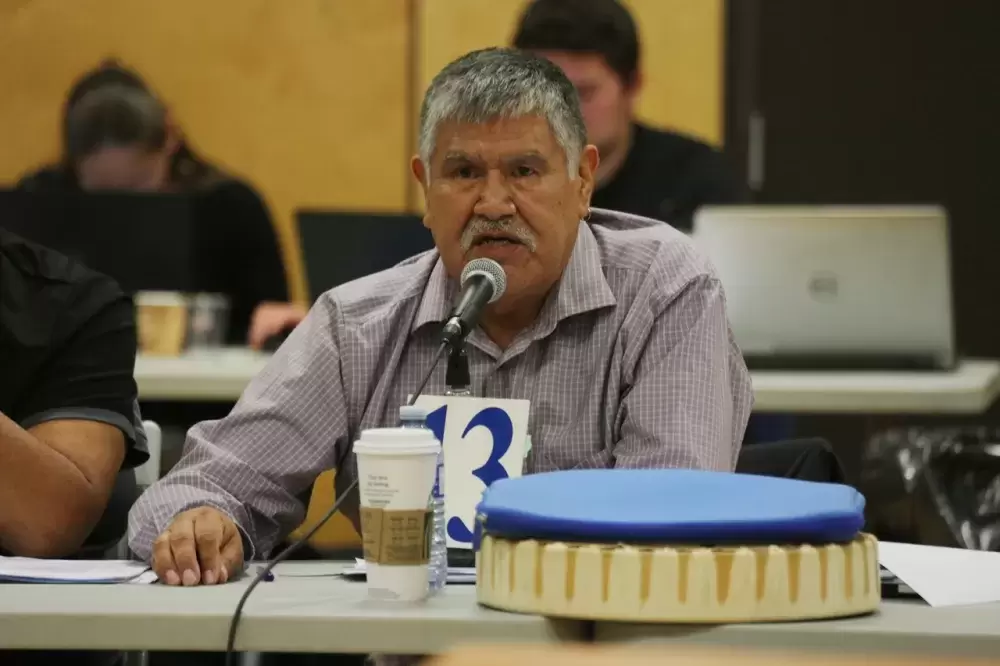After a disastrous year for salmon on the West Coast, Ahousaht is pressing Fisheries and Oceans Canada to place more stringent restrictions on the recreational sector to help conserve stocks.
“Every one of the Ahousaht rivers are in jeopardy of becoming extinct of fish,” stressed Tyee Ha’wilth Maquinna, Lewis George, during a recent Council of Ha’wiih Forum on Fisheries. “The sports fishery is taking way too much and we’re not doing anything about it.”
The Ahousaht hereditary chief delivered these words across the table to Rebecca Reid, regional director general for Fisheries and Oceans Canada, during the high-level DFO official’s visit to the fisheries forum on Feb. 5, which was hosted by the Ehattesaht First Nation in Campbell River.
“For the protection of our fish, if the sporties need to be stopped, we’re going to stop them,” continued Maquinna. “We’re hoping that you can talk with your department to say, ‘Yes we’re going to do that.’ If you’re not going to comply, then we have to more forward, honourably.”
Last year Canada’s West Coast fisheries faced stringent restrictions imposed by DFO to protect endangered salmon stocks originating from the Fraser River. Some commercial fleets didn’t see openings until late August, while the offshore recreational fishery west of Vancouver Island wasn’t permitted to retain catches until July 15. Salmon caught for First Nations food, social and ceremonial purposes were also affected by similar restrictions.
Amid these challenging conditions, the west coast of Vancouver Island’s recreational sector saw the highest suuhaa (chinook) allocation with 50,000, while the Area G commercial fleet was initially allotted 14,000 and the T’aaq-wiihak rights-based fishery - which includes Ahousaht, Ehattesaht/Chinehkint, Hesquiaht, Tla-o-qui-aht and Mowachaht/Muchalaht - had an allocation of just over 7,000.
Salmon escapement numbers were revised, and in July the sport allocation was downgraded to 40,000 chinook, which allowed DFO to reallocate 6,000 to the Area G commercial fleet. After being left out of this adjustment, T’aaq-wiihak sought an injunction to block the reallocation, but this was rejected by the Federal Court.
In 2009 the BC Supreme Court ruled that the five nations have the right to catch and sell fish from their respective territories, but over a decade later, Nuu-chah-nulth fishers have seen few benefits from this decision. In 2018 the B.C. Supreme Court identified the priority of the five nations’ fisheries over the recreational sector – despite what is evident in the DFO’s Salmon Allocation Policy.
Frustration with the federal department’s jurisdiction over Nuu-chah-nulth hah=uu>i was evident during the recent fisheries forum. Maquinna recalled an encounter last year when he was followed and stopped at the dock by DFO officers for fishing in Ahousaht territory. One of the officers told the chief he was fishing during a closure.
“I never gave the closure,” said Maquinna. “Nobody sits above this table, and that’s the problem with government. The provincial and federal government don’t recognise the ha’wiih, the hereditary seats that were passed down 17 generations back.”
Although there weren’t any commitments to change recreational allocations in 2020, Wilf Luedke, section head for DFO’s station in Nanaimo, announced that the federal department will be working more closely with fishing guides to ensure catches are accurately recorded. The recreational sector is largely based on voluntary reporting from boats, but Luedke said DFO is looking to implement log books for guides to provide more thorough records. He estimates that sports fishing guides account for approximately 20 per cent of recreational catches on the B.C. coast.
“They have an extra responsibility, given that they’re catching a lot of fish,” said Luedke.
The DFO has identified chinook on Vancouver Island’s west coast as a “stock of concern” since 1996. In his presentation for the Council of Ha’wiih, Luedke noted that research from Ahousaht and Huu-ay-aht territory shows fish are leaving rivers in a more vulnerable state that previously.
“Bedwell and Sarita studies show smolts are leaving rivers quickly at very small size…due to loss of complex rearing habitat and food in the rivers,” stated Luedke’s presentation document. “This small size makes them vulnerable to disease and predation in the first few months at sea.”
According to his presentation, the threat of fishing the struggling stocks is being reduced. In most years before 1995 more than half of the chinook off the west coast of Vancouver Island were being caught – with the exploitation rate as high as 70 per cent in the early 1980s. In recent years this has declined to around 35 per cent, cited Luedke.







